February 2008 Archives
I just took a look at the final layout of my card game book. Now I only need to do the index and make the last check for mistakes, and it's done. The book goes to the printers about week from now. It's gorgeous - most of the card game books I've seen are pretty bland, but not this one.
The publisher decided to make it a large hardcover to avoid making it hundreds of pages long (the manuscript was bit on the long side). Now it's packed full of text and 240 pages. Also, it's pretty expensive, so it has to be hardcover to justify the price (of course it being a hardcover is one reason why it's expensive, but I'm sure there's some logic to all this). It gets better: I was hoping for few colour pages to show off some beautiful cards, but they'll print the whole book in four colours. So, there's plenty of colour all around.
The layout is very beautiful, Tarja Kettunen from BTJ did wonders on it. The book is - of course - red and black all over. I really, really like it. I'm quite proud of it, actually, as I think it's much better than my first book, and I'm very glad to see it treated this well by the publisher.
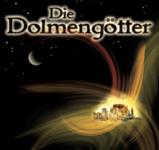
Die Dolmengötter is an ugly game. The theme is also silly: the game is abstract as heck, and while I understand that theming it must've been a real struggle, one wonders if this is a game that should simply be an abstract without any attempt at theme. Thomas Odenhoven's other game, Portobello Market, works better in this respect (though Dolmengötter is the better game of the two in any other sense).
These minor problems make the game rather unattractive and I skipped it back in Essen 2005. I've been interested in it along the way, every now and then, mostly thanks to JC Lawrence's comments on Geek, and when Tommy had it for sale, I bought it. The game hit the table yesterday and was a success, at least in my opinion.
I played the game twice, with three and four players. The idea is fairly simple and the rules are pleasantly easy to explain. Druids run around the board dropping stones on the stone places that are on the border between the different areas on the board. Once a player has a majority of stones around an area, he gets to place his dolmen in the area. To get a majority, one needs opponents: one stone alone isn't enough.
Once someone has a majority, another player can equalize. In that case the player places a dolmen, but it goes under the stack of dolmens. So, whenever a player gets a majority, dolmen goes on top of the pile and when equalizing, the dolmens go under the stack. What's that all about, then, I hear you ask.
Well, once an area is complete (or game is over), the stack is scored. Each dolmen has a point value (1-4 points) and that is multiplied by a factor depending from the location in the stack. Top of the stack gets highest factor (up to 5x), while bottom of the stack is worth less. So, a dolmen can be worth one point (1x1) or twenty points (5x4) depending on where it is.
It's all very interesting, and figuring out the best way to place the stones and the dolmens isn't easy. Players need help from others, because the worst thing you can do is just place your stones in circles where nobody else goes, they're wasted there all alone. To get cooperation, you need incentives, because nobody isn't going to just help you without getting anything for themselves.
What's best, the game can be played in 20-30 minutes. It moves fast and left me wanting more. I'll be carrying this one around on Thursday nights for a medium filler purposes because the rules are so easy to teach. I'll have to try JC Lawrence's variant at some point.
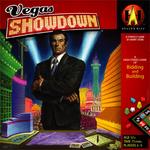
Vegas Showdown was the other new game I wanted to try and we got that done as well. This one took about 60 minutes to play with three players, which was nice. The rule book isn't very good, I found it frustratingly vague about certain things, but we were able to play the game without any problems.
It's good. Players buy stuff from auction, in an attempt to improve their casino hotels. When you buy stuff, you get more revenue and population in your hotel and you also try to collect as much fame as possible. I like they way income is based on lower of revenue and population, which makes raising income a slow progress. The feedback loop is very mellow.
I like the game. We had a close game, too, all players within six points and a minor change would've changed the final order (I won). While the game was close, it perhaps lacked tension a bit, but that might be because we had just three players. Vegas Showdown feels like a family version of an engine game, perhaps, in many respects. I think the game would work pretty well with non-gamers as well, thanks to the very attractive theme. For more hardened gamers, it's more of a relaxing little snack.
Still, it's a good game and certainly worth the 20 euros or so I paid.
We finished off with few hands of Slovenian Tarok. I think this was the first time I ended the game on positive points? Out of the four hands we played, I took the lead in three. First one I lost, second won after lots of excitement about the identity of my partner and in the third one, I rocked. The first five cards or so I saw of my hand included all the three major trumps.
I chose to play solo three, which I won easily (well, 42 card points, which was enough), scoring a declared Trula and undeclared (and I wonder why) pagat ultimo for a total of 91 points. Sweet. So this is how it feels like to have a hand of good cards...
If anybody has a copy of Prairie Railroads, Veld Railroads or Pampas Railroads they're willing to sell, please let me know.
As if, but doesn't hurt to ask, does it?
I just moved my blog subscriptions from Bloglines to Google Reader, because Bloglines blanked out yesterday - no updates on any blogs at all. It seems to work now, but perhaps I'll try something else for a while. Changing readers is fortunately very simple, as all good feed readers use standard export/import tools. The compatibility is amazing!
Anyhow, I was weeding my board game blog list and noticed that it's really thin: it seems most of the blogs I'm subscribed to have been abandoned. I haven't followed the new stuff, either. So, how about some recommendations? I checked the BGIA nominees and subscribed to most of those. Any other recommendations?
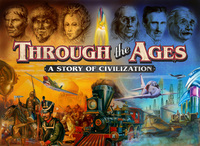
I was planning to play something else (my new copy of Die Dolmengötter, to be exact), but I got Through the Ages and it was requested, so that's what we played.
And that was indeed all we played. We started about 16.45, I took perhaps 30 minutes explaining the rules and about 17.20 we got the game rolling. Two hours and fifteen minutes or so later our three-player advanced game was over.
It was fun, though I can tell you this is not a fun game to explain! I had played once before and studied the rules, but I didn't have a clear idea of how to explain it. Gargoyle said later it was one of the most confusing games he has ever played, and no surprise.
Well, he did quite well, as he was in the lead most of the game and won hands down. But then again, he was the only one of us with a steady flow of culture points each turn... I had, once again, huge problems getting my engine to work. I kind of did well, and then didn't. I was basically missing something critical every turn. It was frustrating and annoying, but in a good "I need to play this again to get it right" kind of way.
It's a tad long, but playable on Thursday nights, if we stick to the advanced game and a maximum of three players and preferable avoid the slower players. It's that long... But with experience, there should be no problems playing it in two hours and if you can skip the rules explanation, the timeframe works well.
Queen Games is expanding to Scandinavia, it seems, as I was just hired to translate their games to Finnish. It's funny how this internet thing works, you just get interesting job offers out of the blue!
Once somebody wrote to me and said he enjoyed my blog and asked if I'd like to write about games in this magazine he's editing. Well, that email got me a job as a columnist and has since lead to several magazine articles, two books and plenty of other interesting tasks (most recently setting up an internal wiki for a small publishing house!).
Now this! I'm translating Eketorp and Thebes. Eketorp seems like a rather splendid blind bidding game - somebody compared it to Edel, Stein & Reich on Geek, and that's one of the games I dislike the most - but Thebes is somewhat more interesting. Nice to see them come out in Finnish, anyway.

I bought some new games. Through the Ages was a must-buy after I played it with Tommy last year. I picked my copy of the second edition yesterday. A lot has been said about the production values of the new edition. I have little to add, except that it isn't that bad and it sure looks like it's made in China.
I don't like the Chinese shrink-wrap, that's for sure. Well, as I said, it's not that bad, especially if they're issuing replacement cards for the misprints. Replacement board is nice as well, though I think the numbering error (the culture score track jumps from 80 to 100, skipping 90) is really minor and seems a bit wasteful to me to print replacement boards and send them around the world to people. After all, it's such a small detail that doesn't affect play at all.
The cards might be a bigger problem, if they curl up or otherwise destroy themselves. I've got sleeves, so that should probably fix that. They don't seem very durable. The tiny beads of the original edition are replaced by tiny cylinders - I'm not a huge fan of either, but I do understand bigger bits would mean bigger boards and the game takes enough space as it is.
One question about the cover: why they put the choking hazard warning straight on the box cover? I understand they had to have that on the box, but why put it so visibly on the cover? It draws attention from the cover art (which I think is just fine).
In any case, the production values are decent and the game itself rocks. We're playing tomorrow!
I went hunting for card sleeves to the friendly local game store (formerly known as unfriendly local game store). I was disappointed, because they didn't have any. Bummer. Then again, the board game sleeves I was hunting for are a minority item and probably won't sell that much, as they only fit few games. They're perfect for Through the Ages, though, so I had to order them from Lautapelit.fi.

Well, I did check their games for sale table and I just had to buy Vegas Showdown. 22.50 euros, not bad! I haven't played it yet, but people I trust like it, so it can't be bad. Besides, I can probably sell it for 15 or 20 euros if I don't like it. But I do expect to like, it looks great and the rules made immediate sense.
I'm also contemplating about extending my 18xx collection (damn the rail bug). Currently I'm considering to buy 1860 and/or Steam over Holland... Heck, who am I kidding, it's "and" and the real question is "when". I mean, 1860 is good, I know it because I've played it and enjoyed it. Steam over Holland promises shorter playing time, meaning I could perhaps get a game done in our Thursday sessions. That would be cool.
Oh, and I just bought a used copy of Ur: 1830 BC.
Yehuda keeps busy with blogging. His latest project is the game news web site Purple Pawn. He covers board and card games. I've added his newsfeed on my side bar, so check it out.
Apparently he's looking for news editors, so if you're interested, get in touch with him.
I spent most of my yesterday attending Tracon. Tracon is a yearly convention here in Tampere, this was the third time it was organized. Tracon is mostly about anime, manga and role-playing games. In the first two Tracon's, I don't think there was any board game presence, but this time the Finnish Board Game Society organized a small board game room. Since Tracon was close and friends from outside Tampere were attending, I joined the fun.
It was quite popular event, with about 3000 people attending (according to the web site). The defining element of Tracon was without a doubt cosplay. It seems to me that cosplay is the new live-action role-playing. When I was a teen, larping became popular (I was among the first major LARP wave back in 1994 or so), now it seems cosplay is the hip thing to do. Japan is very popular in general, I think most kids who start drawing comics these days adapt a very manga-influenced style and J-rock is quite popular.
Which is cool, and certainly made Tracon interesting to see. Most of the attendees were fairly young, I think. While board games in Finland are popular over wide age spectrum, the hard core hobbyists are "university age", that is 20-25 or so, well 20-30 perhaps (I'm getting closer to 30 myself, so extension is needed here). These cosplay folks are probably around 15-20. High school kids, that is.
Our little board game room (the event was held on the local technical university, a pretty nice venue actually) was a small class room, with nice differential equations decorating the black boards from Friday's lectures... It was a pleasant center of normality in the con, as most people in costume avoided it. We had a fairly small bunch of hard core board game folks, I'd say probably less than twenty people spent their whole day playing board games. That was quite enough, though, and quality certainly beats quantity.
Well, the costume people and other anime fans did play some board games as well. I had carried my Crokinole board and, fortunately, it saw almost constant action. I had a rules printout and many people had the patience to learn the game from the rules. That was admirable. I suppose it just looks too cool to pass. The cool factor certainly made the other hit of the day, Hamsterrolle. This group of anime fans played the game for a really long time, having quite a bit of fun. That was very nice.
I was hoping to play Roads and Boats, but the lack of people made that impossible. That wasn't a problem, as I then ended up playing lots of smaller games. Roads and Boats hits the table later, I hope. Oskari had asked me to bring bunch of games he hadn't played, and we ended up playing most if not all the games I brought, and that I consider major success.
As a warm-up, we started with Crokinole. I played with three newbies and the result was rather clear: after four rounds my team won exactly 100-0 (I always play four rounds or 100 points, whichever comes first). It was fun to flick the discs, it's been a while since I last played the game. It's just too heavy to carry in a bus, and nobody ever comes to my place to play games (might be because I never invite anybody).
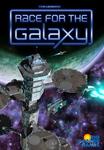
Next up was Race for the Galaxy with Sami, and later I played the game twice with Oskari. It's a nice, swift two-player game indeed, and I even managed to win all three games. And I think Oskari mentioned something about coming to teach me how to play... Well, he did have rotten luck with his cards in one of the games, though I won the otehr despite having rather weak set of cards on table.

I played Dvonn twice, first with Mankka and then with Oskari. Both were new to the game, while I've played it 100+ times (mostly on Little Golem). Interesting enough, while I was able to give Mankka the typical newbie handling, winning every disc, Oskari was able to beat me.
Let me be the first one to admit that I'm fairly clueless with the game, despite my quite extensive experience, though. I've made it to the second level of Dvonn skill and got stuck there, I suppose. I don't mind, because I like playing the game as it is and if newbies can beat me, I'm not sure that's such a bad thing in the end.

Qwirkle was one of the hits. I played it first with Mankka, then with Oskari and as the very last game I played, we had one four-player game. I got some confirmation that the game has a skill element, as I was able to win both two-player games. With Oskari, the final result was 256-183, which was pretty heavy. With four-players, the game was closer. I suppose the two-player game is kind of easier, as you get more tiles and have more opportunities for high scores. I made some pretty nice moves against Oskari, 17, 20, and 21 points! My average was about 7.4 points per move, so those were good moves.
Everybody liked the game and I noticed Mankka taught the game to Cane from Boardgaming Finland. My opinion of the game improved, as well. I particularly enjoyed the two-player games, as they have more turns and less downtime. That's always a bonus, as I don't find player interaction the strongest point of Qwirkle (bit of fixed fun there, I suppose). Not that the four-player game is bad, unless the players are extra slow. So, yes, it's definitely a good game, but I think I'll need to print out a score board, as writing down the scores is kind of annoying.
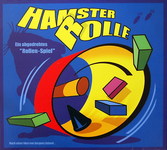
I played a game of Hamsterrolle as well. It's not my favourite dexterity game, but perhaps I just need more practise? Mankka was the only experienced player in our game and it showed, as his team won hands down. I guess I made the biggest blunder, dropping bunch of blocks from the wheel, thus sealing the fate of our team. Hamsterrolle is neat, but I actually might prefer watching the game.

Ubongo Extrem was on Oskari's list of games to test, so we played that next. Apparently Oskari didn't like it, at least not as much as regular Ubongo. I still prefer Extrem, the new scoring is just that good as it makes the game focus on puzzle solving. I do agree with Oskari that the timer is probably too long. I should find a quicker timer somewhere and try the game that way.

Kingsburg was the first new game of the day. This Italian-made game is basically standard resource management: players get cubes and turn them to buildings and victory points. There's worker placement, too. However, the main mechanism of the game is based on Yahtzee-like die rolling.
To start each round, players roll three dice. The board has 18 spots, numbered 1-18. Turn order is determined by the sums of the dice: smallest sum starts, biggest sum is last. Players can take any set of dice and place them on a spot marked with that number. So, if you roll 5-4-2, you could take spot 11 using all your dice, or take 9 and leave the 2 for later. Each spot can be chosen only once per turn, so you have to consider what other players have rolled. Players can also get +2 markers and some buildings allow a bit more flexibility.
Each spot produces stuff, with bigger, harder to reach numbers producing better results. Players must collect resource cubes so they can build buildings, but they also need soldiers. After three turns, there's war against enemies of the kingdom and if players don't have enough soldiers, they'll suffer penalties. There's some pressure and tension there, particularly in the end game when the opponents get tougher.
It's pretty neat and unusual. Oskari wouldn't want to play a five-player game and I can see why: the game has plenty of analysis paralysis potential. Choosing how to use the dice takes some thinking and the situation is sometimes hard to predict, so it's easy to get stuck. We managed to play our four-player game in 70 minutes, which was ok.
I think Kingsburg is ok, but not much more. My main problem is that I didn't have fun playing the game. Quite the contrary, I felt frustrated. I wanted to achieve things, but collecting resources was hard and with the dice having so big a role, it wasn't good hard. I don't mind difficult games, but here I felt I was too much at the mercy of the dice. So, I'd say try before you buy if possible, as I'm quite sure this game isn't everybody's cup of tea.
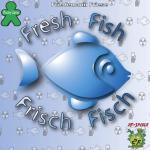
Fresh Fish was another one of Oskari's wishes. Too bad we didn't get anybody else playing. I can assure you this was quite likely my first and last two-player game of Fresh Fish ever. It just doesn't work with two, the board is too small and the auctions get uninteresting. Well, at least Oskari got some idea of how the game works, and he did seem to appreciate the road mechanic, despite his low initial rating for the game in Geek (6, but I wouldn't given a better rating for this particular game either).

Me and Oskari were getting slightly desperate with playing two-player games, that's my excuse for agreeing to play Pünct. I still don't like it, and I actually went and dropped my rating at Geek from six to four. I don't like it, but apparently can be talked into playing it occasionally... Pünct is easily my least favourite in the Gipf series.
Halli Galli Extreme was my party, but then again, opponents were all newbies to Extreme (some were total Halli Galli newbies). It was the same with Flix Mix, where I dominated against players who played by correct rules (one of them didn't, and won the first round).

Next, Tommy appeared out of nowhere (apparently he had been ice-fishing the whole day and decided to join the fray for few hours). Nice surprise! We instantly recruited him to our game of Dia de los Muertos. It was an interesting match of this old trick-taking twister. Points in this game are made of two cards: a soul and food to feed it. Me and Tommy got most of the food, while Oskari and Marko got most of the souls. Too bad we got two souls while they got only one food...
It's a twisted little game with lots of chaos and twists and turns, yet the game offers some good possibilities of control and deduction. I like it. Our game was curious, as of the nine possible points, we scored only three. A bit lame, I suppose. Cue the mantra: I need to get this out more often. Oh, and now I know: Four Dragons is going away, I'm selling it.
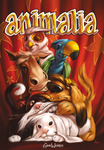
One final new game: Animalia. This is apparently fairly rare filler game, where players try to collect a good set of five animals. Basically you try to collect as many animals of the same kind as possible. If you have at least two of the same animal, you get as many medals as you have those animals. Single animal is worth nothing, unless all your animals are different.
After three rounds, most medals wins the game. There are few twists. First of all dedication helps, as you get extra bonus of five points for every five medals of one kind. Some animals have special abilities, allowing you to give away your animals or steal someone else's animals. Some have stars, and whoever has most stars after a round, gets bonus cards they can use to improve their collection.
It's all fairly simple and entertaining. The game looks pretty cool. The cards have few symbols, though, the different special abilities are integrated in the art. It's neat, but takes some getting used to. We had a bit of a problem, though: we ran out of medals in the end. The rules say nothing about running out of medals. Is that possible? We don't know. It certainly happened. So who gets the last medal? We don't know. The rules don't have a word about it.
That was a bit of a bummer. Later discussion on the Board Game Society forums seems to imply that medals are unlimited, as in the card game version there are no actual medals, they're just counted on paper with no limits. That makes sense, but it still makes things a bit difficult for the version with the insufficient medal tiles.
So, not my favourite, and while it's decent filler, there are plenty of better fillers that have complete, unambiguous rules.
And that's it. Tracon was fairly well-organized event from our point of view. We had the classroom and it was enough for us (though bit more traffic at the peak times and we would've run out of space), our tested game borrowing system worked well and didn't require much effort from our part. People played games and had fun.
Thanks to Mika for organizing a pizza delivery, that solved the food thing well. I didn't even have to leave the game room to eat, how efficient! I will definitely attend Tracon again if Board Game Society decides to have some presence and it fits in my schedule.

I met Sami for some Memoir '44 with the Air Pack. We had time for two scenarios, both from the Western front. We played Carentan Causeway and the Battle for Arracourt. The first one was a quick one, because of my careless playing. The second was more interesting and in the end, I won 6-5, but it was close.
So how's the Air Pack like? Excellent! We had planes in air in both scenarios. In the first one I used my Storch to rescue a single soldier who was about to die, while Sami tried to strafe my lonely tanks with his Messerschmitt. The planes add complexity and not that much gameplay goodness, at least for starters, but I belive that with more experience, they'll probably turn out just fine.
However, that's not all the pack has to offer. I really like the new scenario book, which collects all official scenarios (basic game, expansions, online stuff and con scenarios) and sorts them by front and date. The scenarios are also updated, so even the basic game scenarios utilize stuff from later expansions. One of the early expansions, for example, is a night attack and roads have appeared on many maps.
That's very nice for us who own all the expansions. Of course, if you don't have any or just have one of the two main expansions, it's a lot less useful and by itself, Air Pack is clearly the worst expansion. However, once you have everything else, it pretty much becomes a must-have. The description cards for just about everything, for example, is a really nice thing to have. Though I must say, finding the correct one of the 60 or so terrain effect cards gets pretty tricky...
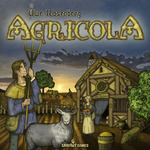
I visited Jyväskylä last weekend. Agricola was a must after last time. This time the boys were out of town, so it was just me, my mother and Ismo. We managed to play two games, first one taking 60 minutes and second one just 50 minutes.
That's very nice efficiency and certainly reinforces Chris Farrell's comments about Agricola being fixed-fun game (see Iain's blog entry about Agricola). I agree to some extent: the five-player game is good, but takes too long. I'd rather play two three-player games in the same time.
How it went? Well, I won the first one, then lost the second when my mom and Ismo both improved their game. In the second game, I spent way too many actions feeding my family, emphasizing the need of effective food production. Still, fun, fun, fun!
We played a game of Caylus Magna Carta, too (I had given it to them as a Christmas present). I thought I didn't do that well, but actually won by one point. I did pretty much nothing in the last few rounds, but obviously had done enough before... Had the game lasted for one more round, I would've probably lost. That's lucky, especially as I did nothing to actually end the game.

I played Battle Line and Xiangqi with my brother. Battle Line is probably the game we've played most together, excluding CCGs (include them, and it's either Magic or Vampire).
He played a great game of Xiangqi, though. He hadn't played before and had some usual trouble with the pieces, but managed to beat me eventually. I thought I won the game twice or so, but he managed to survive and mated my king in the end. Well played, and a very exciting match!
We have a bit of Xiangqi history, actually. Years ago, at least 15 years ago or so, we found this set of wooden discs with oriental writing on them in the old family farm house. We had no idea what it was; I just remember being disappointed it wasn't a Mahjong set (I knew and loved the solitaire tile-picking game back then). With no rules, board or any explanation included, we just toyed around with the pieces.
When I started getting into Xiangqi recently, I was finally able to identify that old game as Xiangqi. It was a nicer set than mine, too, with somewhat larger pieces. The board was either missing or separate from the pieces. So, no wonder my brother was interested in trying the game.
He had brought his latest time-waster with him. Guitar Hero III and two guitars... Well, I had to try it (I've played Guitar Hero II once before). It was fun, and playing together was pretty cool. While my mom and Ismo entertained Nooa, we played through the co-op career mode on easy. While it was fun, it's not a game I feel a need to own and practise a lot... Not my game in that way, no.
In other video game news, I've enjoyed Legend of Zelda: Phantom Hourglass on Nintendo DS. It's pretty nifty with all the DS-specific interface stuff. Lots of drawing, writing, scratching and swishing with the stylus, blowing and shouting with the microphone and other things like that, all very well done. As far as game design goes, it's Zelda alright, in good and bad.
I must say though, as I play only when Nooa is sleeping, yelling isn't quite my favourite game mechanic...

After clobbering Hannu in Sunda to Sahul, it was time for Golden Compass. We had full table, four players, and off we went, on our trip to the other universe. The card playing mechanism was definitely more interesting with four players: you really had to think a bit when choosing which cards to take.
However, our game took over an hour, which was way too long. I ran out of patience long before the end. In the end I won our extremely close game: everybody made it to the goal space on the last turn and it was up to the tie-breaker rule to resolve the winner. I'm fairly sure that's going to happen often. Not to me, though, as I'm not playing this one again, at least before I have a family with which I can play. With gamers, this one's a almost complete waste of time.
Race for the Galaxy was played. I did well with rare elements, though lacked the final oomph and lost to a fairly well-oiled novelty produce-consumer.

Halli Galli Extreme was one of the hits of the evening. Instead of counting to five matching fruits like in the regular game, here you slap the bell when two identical cards appear. Cards can have multiple fruit in them and it's surprisingly hard to tell banana-plum-strawberry and banana-lime-strawberry apart fast enough... There are also animals: if there's a pig, you always slap; if there's an elephant, you slap unless there are strawberries; if there's a monkey, you slap unless limes are present. What's even worse, when an animal says don't slap, you don't slap even if other cards would require a slap.
It's all very confusing and of course, all great fun. If you like the regular Halli Galli and it gets regular play, buying the Extreme should be a no-brainer. It adds such a delicious twist to the game.

I hadn't played China before. About time, I'd say. This redevelopment of Web of Power cuts off the half-time scoring but is otherwise essentially the same game. The original is a very good area majority game and China is no different. We played a quick three-player game, in about 15 minutes. Not bad! I played all my temples and then had to waste my last turn by playing useless advisor. My temple rush did quite well enough, though, as we tied the game with Hannu, who dominated the advisors.
It was fun, and reminded me of what an excellent game this is. I think I slightly prefer the European map, but otherwise I don't care which edition I play. 15-minute games don't get much better than this.
We finished with a five-minute For Sale, which is nice, but perhaps a tad... well, bland? I mean, you just play it and that's it, you don't really care about it. Well, it's a good game, nevertheless, and a top-notch filler for those pesky little five-minute spots.
When I arrived, people were already playing Polarity. I don't know if it's a good game or not, but it sure looked very, very cool. Otherworldly, I might say.

I tried Settlers of Catan Junior with Johanna yesterday. The game is a simplified version of Catan with an age recommendation of 6+. It has all the basic elements of Catan: production rolls, trading and building. Everything is just simplified. Production rolls are just d6, building rules are easier (players must build villages next to each other with exactly one road between them) and the development cards are easier. To help trading, there's a marketplace where players can make one 1:1 trade each turn.
It's simple, probably fun, but obviously offers very little to players over 10 years old. However, this just might be a good way to get the young ones hooked to Catan. We'll see in, what, three years, when Nooa turns five and I can start pushing these more difficult games.
Johanna won, by the way, but was quite frustrated with the game. The decision-making is mostly obvious, but the game has the ugly side of Catan everywhere: sometimes the bloody die just keeps on rolling stupid numbers... but I suppose that's something that doesn't change.

Golden Compass is an excellent book (and a fairly mediocre movie), and of course it has spawned a bunch of board games. Most of them are based on the movie, but Der goldene Kompass by Kosmos is based on the books.
It's a race game: players try to go through the board as fast as they can, while collecting enough experience to fulfill a number of mission cards. Movement is by cards, and here lies the trick of the game. After the beginning stages, players can only use certain cards. Cards have different colours, matching to the players. The player who is first can only use cards of his or her own colour. The others can use cards that match the colours of the players in front of them.
That's basically it. Each turn players can move as much as they can. Turns start with the draw of new cards, where the leader of the pack draws just one card and the rest will each get one card more than the player in front of them. Thus the game is a race full of balancing mechanisms. I'm sure it's really, really difficult to win with a wide margin.
We played with two, which works, but takes some changes from the basic game. It was ok, though very easy. No real challenges here! I lost, though I would've made it to the finish on the next turn. I was probably in the lead for few turns too much: this is one of those games where it's best not to lead.
The two-player game is slightly boring. I'm sure the game is better with four players. In any case it has little to offer for gamers, it's a family game and that's it. A good family game, that's for sure, and one I would love to play with kids. However, I'm probably going to stash this one in storage until Nooa is older.
Before, I used to do "related games" in my Finnish game reviews by hand. That's boring and when you add a new review, deciding where to add the new game as related game is tedious. So, that needs automation. But how? I decided to do a two-part tagging system: theme and mechanics.
I did the theme part months ago. It was fairly easy, though took some time as I had about 170 reviews by then. Still, fairly simple, and the results were decent and in some cases quite good (tags like "Catan" or "abstract" worked quite well).
It took me until now to start on the mechanics. That's a lot harder. You can see it in the Geek, where the mechanics listed for game are usually missing or at least not quite good enough. And consider that I have now almost 200 reviews to tag... Well, some mechanics are easy, like "roll and move", "set collection", "auction", "trading" and so on, but others are much more complicated.
Take, for example, speed games. I first tagged these as "reaction games", which describes something like Halli Galli, but doesn't feel right for Ricochet Robot. So, I changed it to "speed games", while keeping "reaction games" for the likes of Halli Galli and Snorta! I had also tagged these as "simultaneous", but the simultaneous action in Sunda to Sahul is different from the simultaneous action in Diplomacy or Race for the Galaxy. So, one remains "simultaneous", while the other becomes "real time".
What about "modular board"? Catan has modular board, but what about Carcassonne or Tikal? The way I see it Carcassonne doesn't have a modular board, while Tikal does. The difference is that in Tikal, you actually play on the board that is grown, while in Carcassonne, you just lay tiles. Carcassonne is "map building".
Is "hex based" a good tag? Perhaps within wargames, but I don't think the fact that Catan is hex tiles and Tikal has hex tiles makes them really like each other in an interesting way.
It's not simple, tagging the games like this, but at least I have a clear goal: I want tags that help link similar games together. That helps a lot and gives me ways to tune the system, as I can work the tags until I see similar games grouped together.

Another good session, this time with more shorter games. That's nice balance. We hit off with Flix Mix, a favourite of mine I hadn't played in a while. It's a small Adlung card game, those just get stuck somewhere and then you forget about them. We played a practise round, which I didn't win and then a proper four round game where I won each round. Ah, the sweet success.

Next up was Qwirkle. The game looks like Ingenious, but actually plays more like Scrabble. The game consists of stylish black wooden tiles showing six different symbols in six different colours. Players lay the tiles on the table forming rows of two or more tiles. Each row must have either one symbol and different colours or one colour and different symbols. You score points for the length of each row you add to (like Scrabble with tiles that all are worth one point) and get a bonus for doing a six-tile row.
It's simple and fun, and I'd say it's a good gateway game if any. The concept is dead simple, everybody is able to learn and play the game and playing it is, for the most part, quite fun. Our game was fairly close, so close that I wonder how much there is skill and how much it all is about getting lucky. Well, I'm sure the effects of skill will surface if I play the game more. Then again, I don't think it's a huge problem if an experienced player can't automatically clobber newbies.
So yeah, I like it and I think it certainly has some classic potential. I mean, the basic idea is definitely in the simple but solid category, the game looks good and it's fun to play, too. So why not? I currently rate it as solid eight, with a possibility for a higher rating if the game ends up hitting the table often enough. A keeper.
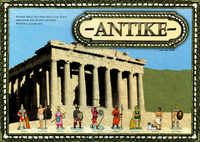
Then, Antike. We had a bunch of newbies, me and Hannu, who had played once. Five of us took the Middle-Eastern side of the board where I looked forward to leading my Egyptians to glory. As a strategy, I decided to go for gold. I expanded my kingdom a bit to get the five-city point, then built two temples on gold cities and started getting rich. Since my opponents weren't a threat, I forgot expansion and military building and focused on science instead.
I didn't actually get that many science victory points, two or at most three. However, I did get all the know-how developed. Combine that fact with my production of eleven gold on each gold action (three gold cities with temples and currency) and as it turns out, I never produced marble or iron again in the game. With my gold, I built huge armies (first 12 units, then 15) and used them to collect the rest of the points I needed.
It was fun. By no means it was completely obvious, the other players were doing pretty well too. Well, after my assault on Hannu's arabs, it was pretty clear he wouldn't win the game. The end game wasn't quite satisfactory anyway, and this game sealed my decision: from now on, I'll start everybody with one victory point. Our game wasn't too long, just 90 minutes, but it would've been even better without the last 15 minutes, I think. It's a simple fix that should improve the game.

Last time I had beaten Hannu in Halli Galli. Well, he got his own copy and played with his students (he's a teacher and runs a game club at his school, which is very cool) and boasted he was pretty good at it now. Well, he was right. I got to the bell first exactly once, rest of time I was slapping his hand. It was rather amazing, hard to believe. Of course he won, my one success was the only match he didn't slap.

Hannu had bought Battle Line, but hadn't yet had a chance to play it. I was eager to help him, as Battle Line is one of the games I've played for years and still enjoy a lot. Our two games went 1-1, in the first one I thought I'd won, but my cards weren't quite enough. Second one I took, but not by a huge margin. I've won slightly over half of my Battle Line games so far... but it's usually entertaining whether I win or not.
